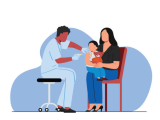Nov 6, 2002 (CIDRAP News) Federal health officials have taken the unusual step of asking the public its opinion on whether the possible benefits of testing smallpox vaccine in a small group of children are worth the risks.
The National Institutes of Health (NIH) proposes to test the decades-old Dryvax vaccine in standard and diluted concentrations in 40 children aged 2 to 5 years. The Department of Health and Human Services (HHS) described the plan and invited comments in a notice published Oct 31 in the Federal Register.
The notice invites people to comment on whether the risks to the children are "reasonable in relation to the anticipated benefits, if any, to the subjects, and the importance of the knowledge that may reasonably be expected to result." The deadline for commenting is Dec 2.
The proposed study will involve a total of 40 children at two centers, Harbor-UCLA Medical Center in Los Angeles and Cincinnati Children's Hospital. Besides testing the safety and immunogenicity of the vaccine, investigators will assess whether semiocclusive dressings can keep vaccinia virus from spreading from the inoculation site to other parts of the body and to other people. In addition, children who don't show a skin response to the vaccine (a "take") will be revaccinated about a week later to test the value of a second dose.
Historically, smallpox vaccines caused life-threatening reactions in about 15 people per million vaccinated and caused death in about 1 in 1 million cases. The Bush administration is currently weighing whether the theoretical risk of a terrorist release of smallpox virus justifies recommending vaccination for healthcare workers or even the public.
HHS has made the protocol report for the proposed study, a 51-page document, available online. The protocol says the rationale for the study has to do with the need to determine the lowest effective dose of vaccine, given the limited supply, and the safest vaccination strategy. (The government has 15.4 million doses of Dryvax in its stockpile, and studies in adults have shown that the vaccine is still effective when diluted 1:5 and 1:10.)
"This is a non-sterile bovine product proposed for use at a time when standards of vaccine safety are much more stringent than they were 30 years ago," the protocol states. Today's population is "essentially non-immune" to smallpox, and there is a greater risk of secondary transmission of vaccinia to susceptible children and adults, especially those with weakened immune systems, the report says. In addition, "Control of possible autoinoculation and transmission from vaccinees to contacts is more problematic for infants or young children than adults. The effectiveness of placing a semi-occlusive dressing over the vaccination site to minimize the risk of transmission has never been adequately studied."
In smallpox vaccination guidelines distributed recently, the Centers for Disease Control and Prevention recommended that children less than 1 year old not be vaccinated unless they have actually been exposed to the disease. The study protocol cites two reasons for using 2- to 5-year-old children. To limit the risk of transmitting vaccinia to others, children would be kept home for at least 30 days after vaccination, a step that rules out using children who are in school. Also, to prevent confusion about potential reactions to the vaccine, vaccination should not occur soon before or soon after administration of other childhood vaccines, making it preferable not to involve children younger than 2 years. The report says the results in 2- to 5-year-old children should be relevant to children of all ages.
The study design calls for recruiting healthy children with no history of atopy, eczema, or other exfoliative skin conditions (risk factors for eczema vaccinatum) and no immune system disorders. Twenty children will receive the undiluted vaccine and 20 will receive a 1:5 dilution. All will be examined 6 to 8 days after vaccination, and those with no "take" will be revaccinated the same way as the first time. Blood samples will be taken about 4 weeks after vaccination to assess the immune response. The participants will be followed for 6 months, and the inoculation site dressings will be changed every few days as needed. For a few of the children, follow-up checks on immune responses will continue for 3 years.
Any children who suffer serious complications other than vaccinial keratitis from the vaccine will be treated with vaccinia immune globulin (VIG), the report states. In addition, the antiviral drug cidofovir will be used as backup treatment if VIG fails to control a vaccinial infection.
Depending on the study results, the protocol also contemplates a potential second study to refine the findings. That study could include another test of the 1:5 dilution and testing of a 1:10 dilution in one or two groups.


















